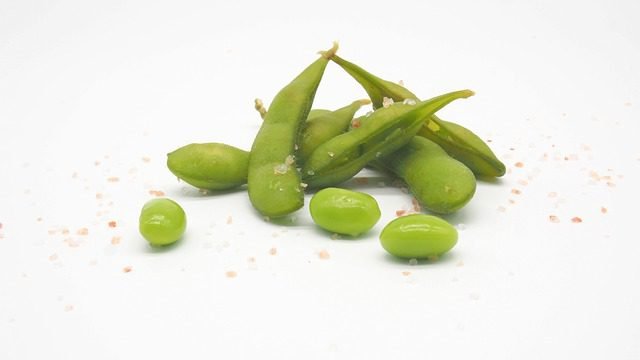

Picture this: a bowl of vibrant green pods, lightly salted, and perfectly steamed. Edamame, the delicious young soybeans, have taken the culinary world by storm. These tiny, tender beans pack a punch of flavor and nutrition, making them a favorite snack, appetizer, and ingredient in various dishes. Ready to dive into the wonders of edamame? Let’s explore their rich history, impressive nutritional profile, versatile uses, and more.
History
Edamame, which translates to “beans on a branch” in Japanese, has been enjoyed for centuries in East Asia. Originating in China around 200 BCE, edamame made its way to Japan, where it became a staple in traditional cuisine. Historically, it was often consumed during festivals and celebrations, appreciated for its unique taste and nutritional benefits. Today, edamame is beloved worldwide, from trendy sushi bars to home kitchens, thanks to its delightful flavor and health benefits.
Nutrition Information
Edamame is a nutritional powerhouse that offers a variety of benefits:
- Protein: Contains 17 grams of protein per cup, making it an excellent plant-based protein source.
- Fiber: High in dietary fiber, with 8 grams per cup, supporting digestive health and satiety.
- Minerals: Rich in iron, calcium, magnesium, and potassium.
- Vitamins: Provides significant amounts of vitamin K, folate, and vitamin C.
- Antioxidants: Packed with antioxidants, including isoflavones, which help combat oxidative stress.
- Low in Calories: With only 189 calories per cup, it’s a nutrient-dense, low-calorie food.
Uses
Edamame’s versatility in the kitchen is unparalleled. Here are ten sensational ways to use it:
- Snacking: Enjoy steamed edamame pods with a sprinkle of sea salt for a healthy snack.
- Salads: Add shelled edamame to salads for a protein and fiber boost.
- Soups: Toss edamame into soups and stews for added texture and nutrition.
- Stir-Fries: Include edamame in vegetable stir-fries for a pop of color and protein.
- Dips: Blend edamame with garlic, lemon juice, and olive oil for a creamy dip.
- Pasta: Mix edamame into pasta dishes for extra protein and a vibrant green touch.
- Sushi: Use edamame as a filling or topping for sushi rolls.
- Hummus: Create a unique twist on hummus by blending edamame instead of chickpeas.
- Buddha Bowls: Top grain bowls with edamame for added nutrition and flavor.
- Rice Dishes: Add edamame to rice pilafs and fried rice for a nutrient boost.
Benefits
Incorporating edamame into your diet brings a host of health benefits:
- Heart Health: Isoflavones and fiber support cardiovascular health by reducing cholesterol levels.
- Bone Health: Rich in calcium, magnesium, and vitamin K, essential for strong bones.
- Weight Management: Protein and fiber promote satiety and help control appetite.
- Blood Sugar Control: Low glycemic index helps regulate blood sugar levels.
- Digestive Health: High fiber content promotes regular bowel movements and a healthy gut.
- Immune Support: Vitamins C and E boost the immune system.
- Antioxidant Protection: Antioxidants help fight oxidative stress and inflammation.
- Muscle Health: High protein content supports muscle growth and repair.
- Skin Health: Antioxidants and vitamins contribute to healthy, glowing skin.
- Energy Boost: Provides sustained energy from protein and complex carbohydrates.
Downsides
While edamame is generally beneficial, there are a few considerations:
- Allergies: Soy is a common allergen, and edamame can cause allergic reactions in some individuals.
- Digestive Issues: High fiber content can cause gas or bloating in sensitive individuals. Start with small amounts and gradually increase.
- Thyroid Function: Contains goitrogens, which can interfere with thyroid function in large amounts, especially for those with existing thyroid issues.
- Processing Concerns: Some edamame products may contain added salt or preservatives. Opt for fresh or minimally processed options.
How to Consume
Here are ten simple and delicious recipes to enjoy edamame:
- Simple Steamed Edamame: Steam edamame pods for 5 minutes, sprinkle with sea salt, and enjoy.
- Edamame Salad: Mix shelled edamame with cherry tomatoes, cucumber, feta cheese, and a lemon vinaigrette.
- Edamame Soup: Add edamame to miso soup for a protein-packed twist.
- Edamame Stir-Fry: Sauté edamame with bell peppers, broccoli, and a splash of soy sauce.
- Edamame Dip: Blend edamame with garlic, lemon juice, and olive oil for a creamy dip.
- Edamame Pasta: Toss edamame with whole wheat pasta, cherry tomatoes, and a light pesto sauce.
- Edamame Sushi Rolls: Roll sushi with rice, edamame, avocado, and cucumber.
- Edamame Hummus: Blend edamame with tahini, garlic, and lemon juice for a unique hummus.
- Edamame Buddha Bowl: Top quinoa with edamame, roasted vegetables, avocado, and a tahini dressing.
- Edamame Fried Rice: Stir-fry rice with edamame, peas, carrots, and soy sauce for a quick meal.
Conclusion
Edamame is much more than a trendy snack—it’s a nutritional dynamo that can enhance your health and elevate your culinary creations. From its rich history in East Asia to its modern-day superfood status, edamame offers an array of benefits that are hard to beat. Whether you’re looking to boost your heart health, improve digestion, or simply enjoy a versatile and nutritious ingredient, edamame has something to offer. So go ahead, embrace the green gem, and let edamame transform your diet and delight your taste buds. Your body—and your taste buds—will thank you.